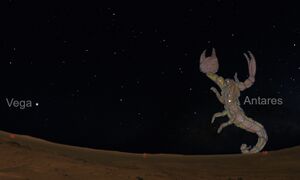BALAG: Difference between revisions
No edit summary |
(minor edits) |
||
| (One intermediate revision by one other user not shown) | |||
| Line 1: | Line 1: | ||
<sup>mul</sup>BALAG is |
<sup>mul</sup>BALAG is an ancient Mesopotamian asterism. With unclear identification, it is not certain what type of asterism (likely a constellation) it was. It occurs only once around 1700 BCE, in the lexical list known as the Old Babylonian Nippur forerunner to Urra XXII (MSL XI 108: 404, Horowitz 2005: 166) inserted between the two entries for ‘The Snake’ and ‘’The Scorpion.’ |
||
==Dictionary== |
==Dictionary== |
||
===Kurtik with Hilder, Hoffmann, Horowitz, Kim=== |
===Kurtik with Hilder, Hoffmann, Horowitz, Kim=== |
||
[[File:Vega+Antares 1250BCE.jpg|alt=Stellarium map|thumb|The two bright stars Vega and Antares rising over Babylon 1250 BCE (Stellarium). Antares rises prior to Vega. This effect is |
[[File:Vega+Antares 1250BCE.jpg|alt=Stellarium map|thumb|The two bright stars Vega and Antares rising over Babylon 1250 BCE (Stellarium). Antares rises prior to Vega. This effect is stronger in the 3rd millennium. ]] |
||
= "Lyra (Harp)"; in [G. 3] <sup>mul</sup>AB<sub>2</sub>.BIR<sub>3</sub>(??); this appears to be a constellation, since in the list of star names before and after it come the names of constellations, the identification is unclear. |
= "Lyra (Harp)"; in [G. 3] <sup>mul</sup>AB<sub>2</sub>.BIR<sub>3</sub>(??); this appears to be a constellation, since in the list of star names before and after it come the names of constellations, the identification is unclear. |
||
| Line 12: | Line 12: | ||
An identification with what would later become classical Lyra remains unproven despite the fact that both Sumerian BALAG and Lyra are in the shape of string instruments: The Lyra-region is known as <sup>mul</sup>[[UZ3|UZ<sub>3</sub>,]] 'The She-Goat' in later Sumerian and Akkadian sources. |
An identification with what would later become classical Lyra remains unproven despite the fact that both Sumerian BALAG and Lyra are in the shape of string instruments: The Lyra-region is known as <sup>mul</sup>[[UZ3|UZ<sub>3</sub>,]] 'The She-Goat' in later Sumerian and Akkadian sources. |
||
In fact, the constellation name <sup>mul</sup>[[UZ3|UZ<sub>3</sub>]] was already in use at the time of the Nippur Forerunner where <sup>mul</sup>BALAG occurs (Horowitz 2005: 169). This suggests that <sup>mul</sup>BALAG may have been an asterism within |
In fact, the constellation name <sup>mul</sup>[[UZ3|UZ<sub>3</sub>]] was already in use at the time of the Nippur Forerunner where <sup>mul</sup>BALAG occurs (Horowitz 2005: 169). This suggests that <sup>mul</sup>BALAG may have been an asterism within the larger 'The She-Goat' constellation, and so that the name <sup>mul</sup>BALAG was already falling out of use by the early second millennium BCE. Greek sources only start in the early first millennium leaving a time gap of roughly a millennium. |
||
{| class="wikitable" |
{| class="wikitable" |
||
Latest revision as of 10:35, 27 September 2024
mulBALAG is an ancient Mesopotamian asterism. With unclear identification, it is not certain what type of asterism (likely a constellation) it was. It occurs only once around 1700 BCE, in the lexical list known as the Old Babylonian Nippur forerunner to Urra XXII (MSL XI 108: 404, Horowitz 2005: 166) inserted between the two entries for ‘The Snake’ and ‘’The Scorpion.’
Dictionary
Kurtik with Hilder, Hoffmann, Horowitz, Kim
= "Lyra (Harp)"; in [G. 3] mulAB2.BIR3(??); this appears to be a constellation, since in the list of star names before and after it come the names of constellations, the identification is unclear.
Pronunciation: The final ‘G’ was pronounced in the original Sumerian something akin to English ‘ng’ or Spanish ‘ñ’ as in ‘señor.’
Gabbay 2019:[1] 133 n. 7, in his discussion of the ancient Sumerian stringed 'instruments' points out that the name of the Sumerian BALAG is onomatopoetic for the sound one makes when plucking a stringed instrument such as a harp or lyre. In later times BALAG came to be a name for a drum (Gabbay 2019).
An identification with what would later become classical Lyra remains unproven despite the fact that both Sumerian BALAG and Lyra are in the shape of string instruments: The Lyra-region is known as mulUZ3, 'The She-Goat' in later Sumerian and Akkadian sources.
In fact, the constellation name mulUZ3 was already in use at the time of the Nippur Forerunner where mulBALAG occurs (Horowitz 2005: 169). This suggests that mulBALAG may have been an asterism within the larger 'The She-Goat' constellation, and so that the name mulBALAG was already falling out of use by the early second millennium BCE. Greek sources only start in the early first millennium leaving a time gap of roughly a millennium.
| Sources | Identifications |
|---|---|
Lexic. texts.
|
II. Deity and symbol.
The sacred lyre as a musical instrument has been known since the Early Dynastic period [Borovskaya 1997; Stauder 1972-75]. Many Mesopotamian gods had lyres. During the Ur III dynastic and later periods, lyres played important roles during temple rituals in Nippur and other cities. The name was recorded often without the determinative d [PSD II, B 75-78; Sallaberger I, 100]. Which lyre served as the basis for this constellation is unknown.
Historical Dictionaries
| Kurtik (2022) | Gössmann (1950) |
|---|---|
| = «Лира (Арфа)»; в [G. 3] mulAB2.BIR3(??); по-видимому, это созвездие, поскольку в списке названий звезд до и после него идут названия созвездий, отождествление неясно.
I. Источники. Лексич. тексты. Одноязычные шумерские списки звезд из Ниппура: mulbalag [MSL XI, 108:404]. II. Божество и символ. Священная лира как музыкальный инструмент известна с раннединастического периода [Боровская 1997; Stauder 1972–75]. Лиры имелись у многих месопотамских богов. В эпоху III династии Ура и позднее они играли важную роль в храмовом ритуале в Ниппуре и других городах. Название фиксировалось часто без детерминатива d [PSD II, B 75–78; Sallaberger I, 100]. Какая именно лира послужила основой для данного созвездия, неизвестно. |
Example |
